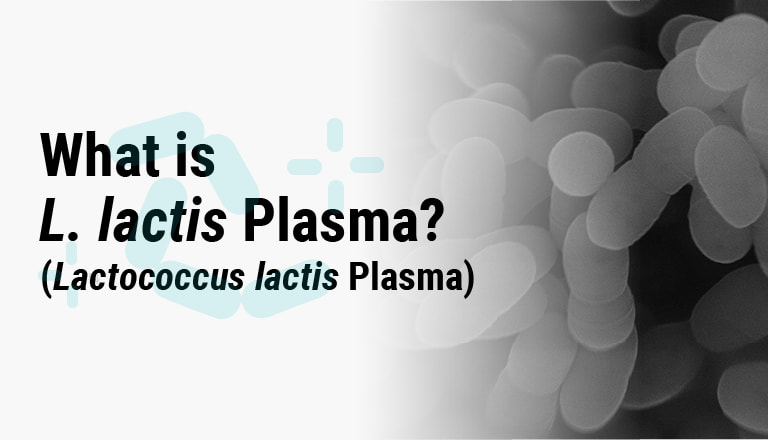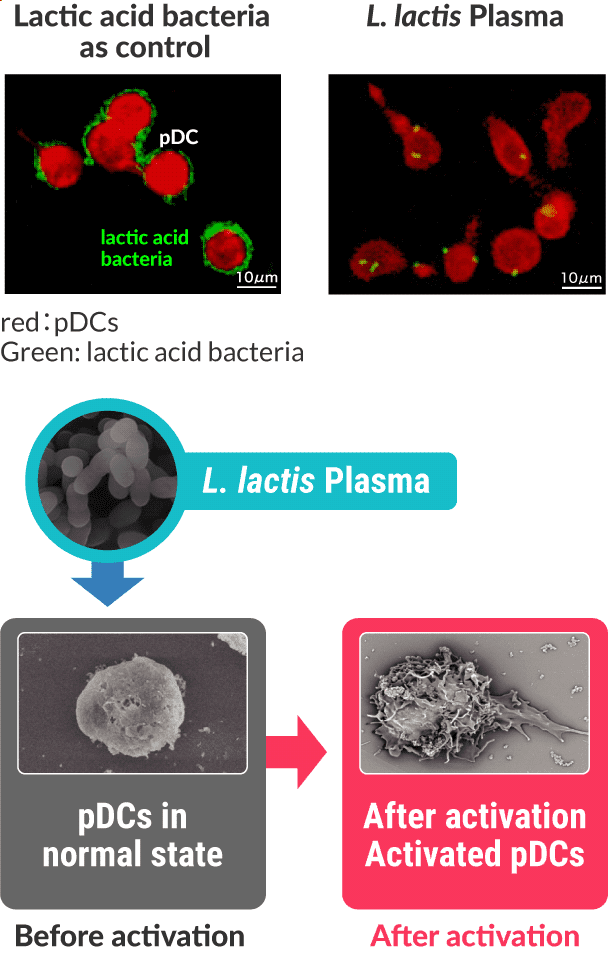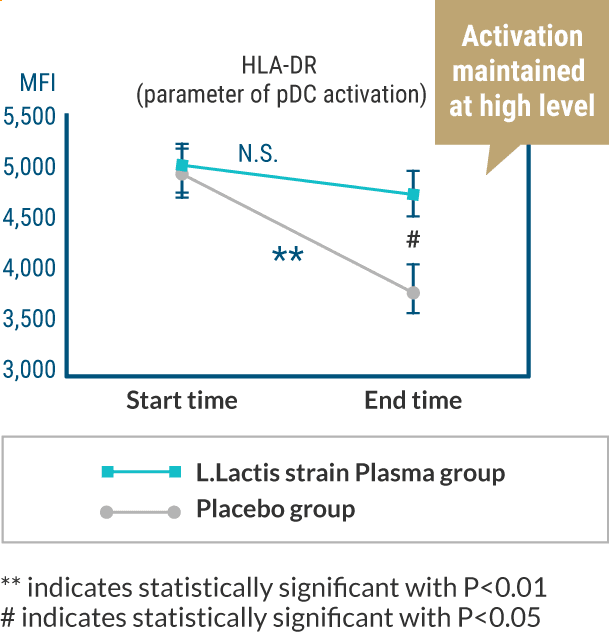- TOP
-
What is
immunity? -
How to keep
the immune system? -
L. lactis Plasma
- What is L. lactis Plasma?
- Effects of L. lactis Plasma
-
Academic Reports and
External
Announcements

What is L. lactis Plasma ?
L. lactis Plasma has special functions not found in common lactic acid bacteria.
01Differences between
L. lactis Plasma and
other lactic
acid bacteria
L. lactis Plasma can activate the entire immune system by directly activating pDCs, the "leaders" of the immune system.

Reference: partially modified from
Pharma Medica 35(7): 69-74, 2017
pDC activation by L. lactis Plasma
It is well known that common lactic acid bacteria activate immune cells, but they only activate some of the immune cells, so the attack against viruses is limited. L. lactis Plasma can activate pDCs, which are the "leaders" of the immune system in fighting against viruses, allowing it to activate immune cells as a whole. The result is the ability to comprehensively attack the virus.
02Comparison of pDC activation
ability of L. lactis Plasma
and common lactic acid bacteria
pDCs produce IFN-α* when attacking viruses, and L. lactis Plasma was able to make pDC produce the highest amount of IFN-α compared to other, common lactic acid bacteria.
*Substances released by immune cells that inhibit proliferation of viruses
Amounts of IFN-α* production when
L. lactis Plasma
and other lactic acid bacteria are added (in-vitro test)

Source: 48th Meeting of the Japanese Society for Pediatric
Infectious Diseases (2016)
L. lactis Plasma and other lactic acid bacteria were added to the pDC culture system, and the amount of IFN-α production was measured.
03Mechanism of pDC activation
by L. lactis Plasma
Absorption and pDC activation in the small intestine
Common lactic acid bacteria can regulate the intestinal environment only when they reach the large intestine still alive, but L. lactis Plasma is equally effective whether alive or dead, and is absorbed in the small intestine to activate pDCs*1-6.

Reference: PLoS One 10(3): e0119055, 2015.
Mechanism of presumed pDC activation in the small intestine when L. lactis Plasma is orally ingested. L. lactis Plasma is taken in through the Peyer's patches, the immune tissue of the small intestine, and regulates the response to anti-viral immunity by activating pDCs.
*1 Clin Immunol Vol 149: 509-518, 2013 *2 Br J Nutr. 114: 727-733, 2015 *3 J Func Food. 24: 492-500, 2016
*4 Pharmacology and Therapeutics (JPT) Vol. 43: No. 10, 2015 *5 Health, 9: 756-762, 2017
*6 J Func Food. 35: 513-521, 2017
pDCs being activated by
L. lactis Plasma
pDCs have an activation "switch" (receptor) inside the cell.
Common lactic acid bacteria only stay outside the pDCs, but L. lactis Plasma is taken inside (see figure on the left).
When it's taken inside, the pDC changes shape and becomes an "activated form" that attacks viruses (see figure on the right).

Left: L. lactis Plasma (right) and lactic acid bacteria as control (Lactobacillus rhamonsus ATCC53103) (left) are marked with green fluorescent molecules and added to each of the pDC culture systems (red indicates cells). It can be seen that only L. lactis Plasma is taken inside the pDCs.
Right: Cell morphology observation by electron microscopy. When L. lactis Plasma is added to a pDC culture system, the pDCs change to the active form, undergoing morphological change.
Source: PLoS One 7(4): e32588, 2012.
04L. lactis Plasma activation of
pDCs (human study)
We have confirmed in human studies that intake of L. lactis Plasma keeps pDCs activated at a high level.
pDC activation in blood during
L. lactis Plasma intake in humans
Thirty-eight healthy men and women were divided into a test food group (19 participants ingested a yogurt drink containing 100 billion L. lactis Plasma) and a placebo group (19 participants ingested a drink containing no L. lactis Plasma), each test food was ingested for 4 weeks, and pDC activation in the blood was measured before and after the test. The results showed that the test food group had significantly higher pDC activity in their blood at the end of the study compared to the placebo food group.
(Randomized double-blind parallel-group study)

Source: Clinical immunology 149, 509-518, 2013.
 The philosophy of our research
The philosophy of our research
and development

Kirin Holdings Company, Limited
Institute of Health Sciences
Dr. Daisuke Fujiwara (Agriculture)
Approaches to health maintenance
through food intake
In addition to viral infections such as influenza that have long been widely recognized by the public, more recent developments in global transport of people and goods have increased the risk of viral infections across countries and regions, and that risk is expected to worsen. Improvements in testing techniques and the development of vaccines and antiviral drugs are underway as means of solving this problem. On the other hand, such approaches are virus species-specific and take a long time to develop. Therefore, we began our research based on the concept of reducing the incidence of viral infections and preventing serious illnesses when they do occur, by increasing resistance to viral infections in general in daily life through intake of convenient and safe foods.
Development of lactic acid bacteria
that activate pDCs
Lactic acid bacteria are known as a safe and easy-to-handle food material that has been utilized by humans in food production since ancient times. The effects of lactic acid bacteria on health functions have been widely studied, and their effects on intestinal regulation and improvement of intestinal microflora are prominent. Lactic acid bacteria themselves are also known to be involved in immunity-activation as an innate-immunity stimulating substance. However, this had the limitation that only some immune cells could be activated. In response to this, we began our search based on the hypothesis that lactic acid bacteria capable of activating pDCs, which are the "leader" cells of anti-viral immunity, would be able to act on the entire immune system as a result.
At the time, the prevailing theory was that there were no lactic acid bacteria that could activate pDCs*. However, we persistently conducted experiments and finally achieved the identification of the lactic acid bacteria that were our objective, which we named "L. lactis Plasma", meaning lactic acid bacteria that activate pDCs.
*Blood 2009; 113: 4232-4239. Human plasmacytoid dendritic cells are unresponsive to bacterial stimulation and require a novel type of cooperation with myeloid dendritic cells for maturation..
Expectations of L. lactis Plasma
as its developer
In this era of 100-year lives, we believe it's important to live a happy and active life. L. lactis Plasma is involved with immunity, which is essential for maintaining human health. I hope that L. lactis Plasma will help everyone, including myself, to live happily and healthily for all the years to come.
Safety of L. lactis Plasma
Soured milk, the predecessor of yogurt, has been enjoyed since the B.C.E. era,
and was offered as hospitality to travelers in the Old Testament of the Bible.
Lactococcus lactis, to which L. lactis Plasma belongs,
is a familiar bacterium used to make soured milk in Europe and has been consumed by humans since ancient times.
In addition, the Kirin Group conducts a variety of safety studies and has accumulated a vast amount of safety data.

Summary of major safety studies
(human clinical trials)
No adverse events were observed in a study in which healthy adult men and women ingested 1 beverage containing 100 billion or more L. lactis Plasma per day for 12 weeks.
Kentaro Tanaka, Hiroaki Suzuki, Masaya Kanayama, Toshio Fujii, Daisuke Fujiwara, Hajime Nozawa, Haruhi Sugimura. Study of safety of beverages containing Lactococcus lactis subsp. lactis JCM 5805 and indigestible dextrins during long-term intake and excess intake. Pharmacology and Therapeutics Vol. 43 No. 12 Page. 1711-27, 2015.
No adverse events were observed in a study in which healthy adult men and women ingested 3 beverages each containing 100 billion or more L. lactis Plasma per day for 4 weeks.
Kentaro Tanaka, Hiroaki Suzuki, Masaya Kanayama, Toshio Fujii, Daisuke Fujiwara, Hajime Nozawa, Haruhi Sugimura. Study of safety of beverages containing Lactococcus lactis subsp. lactis JCM 5805 and indigestible dextrins during long-term intake and excess intake. Pharmacology and Therapeutics Vol. 43 No. 12 Page. 1711-27, 2015.
In a study in which healthy adult men and women ingested capsules containing 500 billion or more L. lactis Plasma for 4 weeks, no adverse events occurred.
Kato Y, Kanayama M, Yanai S, Nozawa H, Kanauchi O, Suzuki S. Safety evaluation of excessive intake of Lactococcus lactis subsp. lactis JCM 5805: a randomized, double-blind, placebo-controlled, parallel-group trial. Food Nutr Sci. 9: 403-419, 2018.

